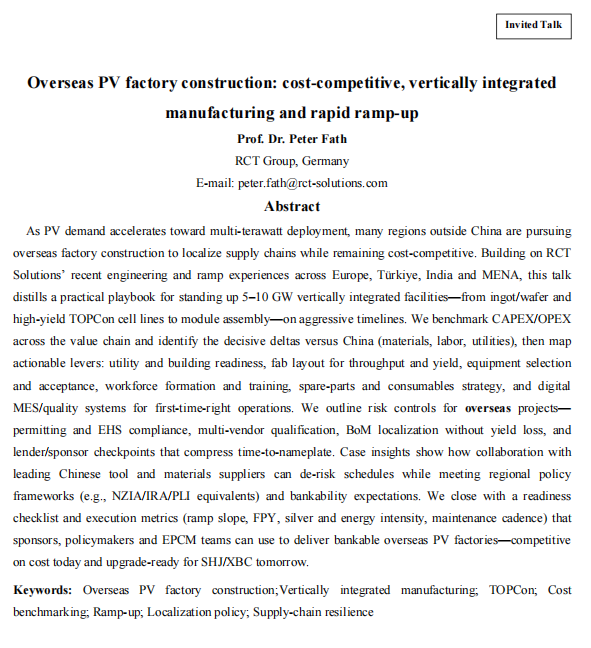| Overseas PV factory construction: cost-competitive, vertically integrated manufacturing and rapid ramp-up【Peter Fath】 |
| 发布时间:2025-10-28 | 浏览次数:172 |
Overseas PV factory construction: cost-competitive, vertically integrated manufacturing and rapid ramp-up Prof. Dr. Peter Fath RCT Group, Germany E-mail: peter.fath@rct-solutions.com Abstract As PV demand accelerates toward multi-terawatt deployment, many regions outside China are pursuing overseas factory construction to localize supply chains while remaining cost-competitive. Building on RCT Solutions’ recent engineering and ramp experiences across Europe, Türkiye, India and MENA, this talk distills a practical playbook for standing up 5–10 GW vertically integrated facilities—from ingot/wafer and high-yield TOPCon cell lines to module assembly—on aggressive timelines. We benchmark CAPEX/OPEX across the value chain and identify the decisive deltas versus China (materials, labor, utilities), then map actionable levers: utility and building readiness, fab layout for throughput and yield, equipment selection and acceptance, workforce formation and training, spare-parts and consumables strategy, and digital MES/quality systems for first-time-right operations. We outline risk controls for overseas projects—permitting and EHS compliance, multi-vendor qualification, BoM localization without yield loss, and lender/sponsor checkpoints that compress time-to-nameplate. Case insights show how collaboration with leading Chinese tool and materials suppliers can de-risk schedules while meeting regional policy frameworks (e.g., NZIA/IRA/PLI equivalents) and bankability expectations. We close with a readiness checklist and execution metrics (ramp slope, FPY, silver and energy intensity, maintenance cadence) that sponsors, policymakers and EPCM teams can use to deliver bankable overseas PV factories—competitive on cost today and upgrade-ready for SHJ/XBC tomorrow. Keywords: Overseas PV factory construction;Vertically integrated manufacturing; TOPCon; Cost benchmarking; Ramp-up; Localization policy; Supply-chain resilience
|






